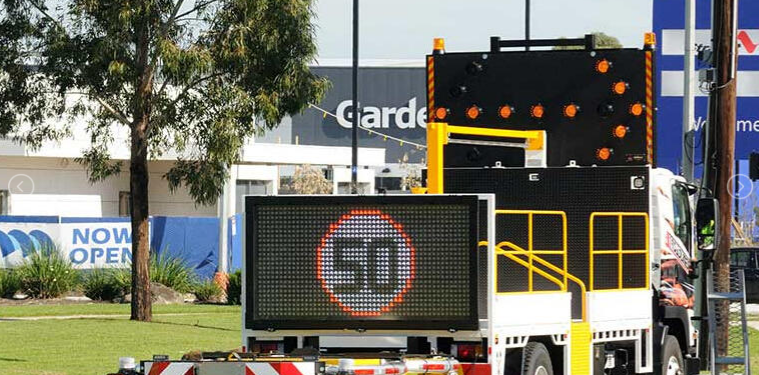可変メッセージサインはどのように機能するのか?簡単なガイド
可変メッセージ標識 (VMS) は、
高速道路や一般道路、高速道路でよく見かける標識で、交通状況、道路閉鎖、安全警報などの重要な情報をドライバーに提供します。これらの電子標識は、現代の交通管理において重要なツールであり、道路の安全性の向上、渋滞の緩和、交通当局とドライバー間のコミュニケーションの強化に役立ちます。この簡単なガイドでは、可変メッセージ標識の仕組み、その構成要素、交通管理における重要性について説明します。
1. 可変メッセージ標識の構成要素
可変メッセージ サインの仕組みを詳しく調べる前に、その基本的な構成要素を理解することが重要です。
- ディスプレイ パネル: 可変メッセージ サインの中で最も目立つ部分です。通常は、ドライバーに情報を伝達するための文字、記号、またはグラフィックを形成する発光ダイオード (LED) のマトリックスで構成されます。
- 支持構造: 表示パネルは支持構造 (多くの場合、ガントリーまたは道路脇のポール) に取り付けられます。支持構造により、適切な距離からドライバーが標識を視認できるようになります。
- 制御システム: 中央制御システムが表示パネルを管理します。このシステムはさまざまなソースからデータと指示を受信し、必要に応じて標識の情報を更新します。
- 電源: VMS には信頼性の高い電源が必要であり、多くの場合、電力網に接続されています。停電時にも機能を維持するために、バッテリーや発電機などのバックアップ電源が使用される場合があります。
- 通信リンク: VMS は、光ファイバー ケーブル、ワイヤレス ネットワーク、携帯電話接続などの通信リンクを介して、交通管理センター、気象監視システム、インシデント報告プラットフォームなどのさまざまなソースからデータを受信します。
2. データソース
可変メッセージ標識は、さまざまなソースからのデータを利用して、正確で最新の情報をドライバーに表示します。これらのソースには次のものが含まれます。
- 交通管理センター:これらのセンターは、交通の流れ、事故、渋滞を監視します。VMS にリアルタイムの情報を更新して、ドライバーが十分な情報に基づいて判断できるようにします。
- 気象監視システム:気象条件は道路の安全性に大きな影響を与える可能性があります。気象監視システムのデータを使用して、大雨、雪、霧などの悪天候についてドライバーに警告することができます。
- インシデント報告システム:これらのシステムは、事故、道路閉鎖、その他のインシデントに関するデータを収集します。VMS は、ドライバーにそのような状況を警告し、代替ルートを提案するメッセージを表示できます。
- 交通センサー:場合によっては、路面に埋め込まれた交通センサーが交通密度と速度に関するリアルタイムのデータを提供できることがあります。VMS はこの情報を使用して、ドライバーに今後の渋滞について通知できます。
- 事前にプログラムされたメッセージ: VMS は、速度制限のリマインダー、安全警告、工事区域の警告など、事前にプログラムされたメッセージを表示できます。これらのメッセージは通常スケジュール設定されており、必要に応じて変更できます。
3. VMSの仕組み
可変メッセージ標識の操作は、いくつかの重要なステップに要約できます。
データ収集:前述のように、さまざまなソースからの情報が収集され、 VMS の制御システムに送信されます。このデータには、リアルタイムの交通状況、天気予報、インシデントレポート、事前にプログラムされたメッセージが含まれます。
データ処理:制御システムは受信したデータを処理し、VMS に表示するメッセージを決定します。たとえば、前方に渋滞がある場合、システムはドライバーに別のルートを検討するようアドバイスするメッセージを表示することを選択できます。
メッセージ表示:制御システムは、選択されたメッセージを VMS の表示パネルに送信します。パネルは LED ライトを使用して文字、記号、またはグラフィックを形成し、ドライバーが遠くからでも簡単に読み取ることができます。
更新頻度: VMS は、新しいデータが利用可能になると、継続的に情報を更新します。これにより、ドライバーは運転中に情報に基づいた決定を下すために、最新かつ関連性の高い情報を得ることができます。
4. 交通管理における意義
可変メッセージ標識は、次のようないくつかの理由から、交通管理と道路安全において重要な役割を果たします。
リアルタイム交通情報: VMS はドライバーに交通状況に関するリアルタイム情報を提供し、渋滞を回避し、移動時間を短縮し、より安全な運転判断を下せるよう支援します。
緊急警報: 事故、道路閉鎖、異常気象、その他の緊急事態が発生した場合、VMS はドライバーに情報を迅速に伝達し、ドライバーが安全を確保して代替ルートを見つけるための適切な措置を講じられるようにします。
安全運転の促進: VMS は、 速度制限、車線閉鎖、悪天候に関する警告などのメッセージを表示できます。これらはすべて、より安全な運転習慣の促進に役立ちます。
渋滞の軽減: 前方の交通状況に関する情報をドライバーに提供することで、VMS は渋滞や交通渋滞を防ぎ、全体的な交通の流れを改善するのに役立ちます。
代替ルートの提案: VMS は交通状況が不利な場合に代替ルートを提案できるため、交通をより均等に分散し、過負荷の道路への負担を軽減できます。
コミュニケーションの改善: 交通当局は VMS を使用してドライバーと大規模にコミュニケーションし、重要な情報が幅広い対象者に迅速に届くようにすることができます。
結論
可変メッセージ標識は、現代の交通管理において貴重なツールです。さまざまなソースからデータを収集し、それを処理し、 LED ディスプレイを使用してドライバーに関連情報を表示します。その重要性は、道路の安全性を高め、渋滞を減らし、交通当局とドライバー間のコミュニケーションを改善する能力にあります。テクノロジーが進歩し続けるにつれて、可変メッセージ標識は、道路上の交通を管理および最適化する取り組みにおいてさらに重要な役割を果たすことが期待されます。









コメントを残す